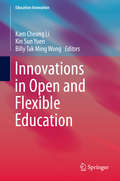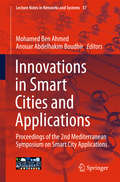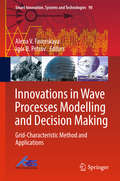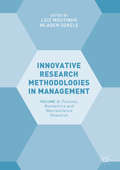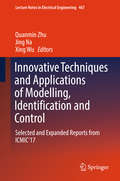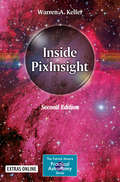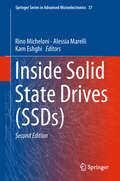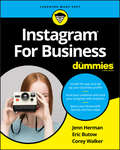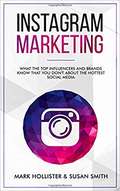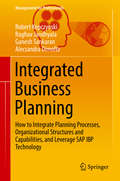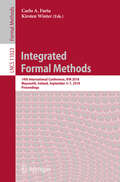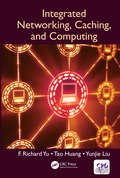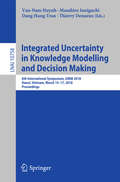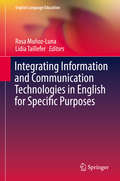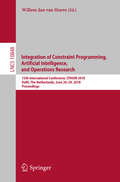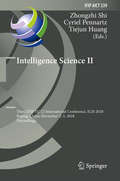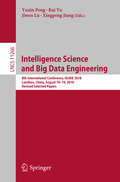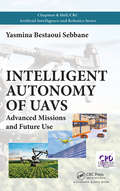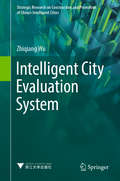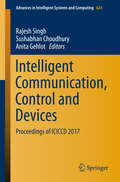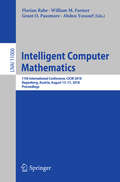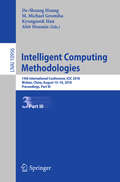- Table View
- List View
Innovations in Open and Flexible Education (Education Innovation Series)
by Kam Cheong Li Kin Sun Yuen Billy Tak WongThis book covers a broad range of innovations in education, such as flipped classrooms, the educational use of social media, mobile learning, educational resources and massive open online courses, as well as theoretical discussions and practical applications in the use of augmented reality and educational technology to improve student engagement and pave the way for students’ future studies and careers. The case studies and practical applications presented here illustrate the effectiveness of new modes of education in which the latest technologies and innovations are widely used in the global context. Accordingly, the book can help develop readers’ awareness of the potential these innovations hold, thus expanding their expertise and stimulating critical thinking as to how new technologies have made learning and teaching easier in various educational settings.
Innovations in Smart Cities and Applications: Proceedings Of The 2nd Mediterranean Symposium On Smart City Applications (Lecture Notes In Networks And Systems #37)
by Mohamed Ben Ahmed Anouar Abdelhakim BoudhirThis proceedings book showcases the latest research work presented at the Second Edition of the Mediterranean Symposium on Smart City Application (SCAMS 2017), which was held in Tangier, Morocco on October 15–27, 2017. It presents original research results, new ideas and practical development experiences that concentrate on both theory and practice. It includes papers from all areas of Smart City Applications, e.g. Smart Mobility, Big Data, Smart Grids, Smart Homes and Buildings, clouds, crowds, mashups, social networks, and security issues.The conference stimulated cutting-edge research discussions among pioneering researchers, scientists, industrial engineers, and students from all around the world. The topics covered in this book also focus on innovative issues at the international level by bringing together experts from different countries. The scope of SCAMS 2017 included methods and practices that combine various emerging internetworking and data technologies to capture, integrate, analyze, mine, annotate, and visualize data in a meaningful and collaborative manner. A series of international workshops were organized as invited sessions during the SCAMS 2017:The 2nd International Workshop on Smart Learning & Innovative EducationsThe 1st International Workshop on Smart HealthcareThe 1st International Workshop on Mathematics for Smart CityThe 1st International Workshop Industry 4.0 and Smart Manufacturing
Innovations in Wave Processes Modelling and Decision Making: Grid-Characteristic Method and Applications (Smart Innovation, Systems and Technologies #90)
by Alena V. Favorskaya Igor B. PetrovThis book presents methods for full-wave computer simulation that can be used in various applications and contexts, e.g. seismic prospecting, earthquake stability, global seismic patterns on Earth and Mars, medicine, traumatology, ultrasound investigation of the human body, ultrasound and laser operations, ultrasonic non-destructive railway testing, modelling aircraft composites, modelling composite material delamination, etc. The key innovation of this approach is the ability to study spatial dynamical wave processes, which is made possible by cutting-edge numerical finite-difference grid-characteristic methods. The book will benefit all students, researchers, practitioners and professors interested in numerical mathematics, computer science, computer simulation, high-performance computer systems, unstructured meshes, interpolation, seismic prospecting, geophysics, medicine, non-destructive testing and composite materials.
Innovative Research Methodologies in Management: Volume II: Futures, Biometrics and Neuroscience Research
by Luiz Moutinho Mladen SokeleA seminal collection of research methodology themes, this two-volume work provides a set of key scholarly developments related to robustness, allowing scholars to advance their knowledge of research methods used outside of their own immediate fields. With a focus on emerging methodologies within management, key areas of importance are dissected with chapters covering statistical modelling, new measurements, digital research, biometrics and neuroscience, the philosophy of research, computer modelling approaches and new mathematical theories, among others. A genuinely pioneering contribution to the advancement of research methods in business studies, Innovative Research Methodologies in Management presents an analytical and engaging discussion on each topic. By introducing new research agendas it aims to pave the way for increased application of innovative techniques, allowing the exploration of future research perspectives. Volume II explores a range of research methodologies including the Spatial Delphi and Spatial Shang, Virtual Reality, the Futures Polygon and Neuroscience research.
Innovative Techniques and Applications of Modelling, Identification and Control: Selected And Expanded Reports From Icmic'17 (Lecture Notes In Electrical Engineering #467)
by Quanmin Zhu Jing Na Xing WuThis book presents the most important findings from the 9th International Conference on Modelling, Identification and Control (ICMIC’17), held in Kunming, China on July 10–12, 2017. It covers most aspects of modelling, identification, instrumentation, signal processing and control, with a particular focus on the applications of research in multi-agent systems, robotic systems, autonomous systems, complex systems, and renewable energy systems.The book gathers thirty comprehensively reviewed and extended contributions, which help to promote evolutionary computation, artificial intelligence, computation intelligence and soft computing techniques to enhance the safety, flexibility and efficiency of engineering systems. Taken together, they offer an ideal reference guide for researchers and engineers in the fields of electrical/electronic engineering, mechanical engineering and communication engineering.
Inside PixInsight (The\patrick Moore Practical Astronomy Ser.)
by Warren A. KellerPixInsight has taken the astro-imaging world by storm. As the first comprehensive postprocessing platform to be created by astro-imagers for astro-imagers, it has for many replaced other generic graphics editors as the software of choice. PixInsight has been embraced by professionals such as the James Webb (and Hubble) Space Telescope's science imager Joseph DePasquale and Calar Alto's Vicent Peris, as well as thousands of amateurs around the world. While PixInsight is extremely powerful, very little has been printed on the subject. The first edition of this book broke that mold, offering a comprehensive look into the software’s capabilities. This second edition expands on the several new processes added to the PixInsight platform since that time, detailing and demonstrating each one with a now-expanded workflow. Addressing topics such as PhotometricColorCalibration, Large-Scale Pixel Rejection, LocalNormalization and a host of other functions, this text remains the authoritative guide to PixInsight.
Inside Radio: An Attack and Defense Guide
by Qing Yang Lin HuangThis book discusses the security issues in a wide range of wireless devices and systems, such as RFID, Bluetooth, ZigBee, GSM, LTE, and GPS. It collects the findings of recent research by the UnicornTeam at 360 Technology, and reviews the state-of-the-art literature on wireless security. The book also offers detailed case studies and theoretical treatments – specifically it lists numerous laboratory procedures, results, plots, commands and screenshots from real-world experiments. It is a valuable reference guide for practitioners and researchers who want to learn more about the advanced research findings and use the off-the-shelf tools to explore the wireless world.
Inside Solid State Drives (Springer Series in Advanced Microelectronics #37)
by Alessia Marelli Kam Eshghi Rino MicheloniThe revised second edition of this respected text provides a state-of-the-art overview of the main topics relating to solid state drives (SSDs), covering NAND flash memories, memory controllers (including booth hardware and software), I/O interfaces (PCIe/SAS/SATA), reliability, error correction codes (BCH and LDPC), encryption, flash signal processing and hybrid storage.Updated throughout to include all recent work in the field, significant changes for the new edition include:A new chapter on flash memory errors and data recovery procedures in SSDs for reliability and lifetime improvementUpdated coverage of SSD Architecture and PCI Express Interfaces moving from PCIe Gen3 to PCIe Gen4 and including a section on NVMe over fabric (NVMf)An additional section on 3D flash memoriesAn update on standard reliability procedures for SSDsExpanded coverage of BCH for SSDs, with a specific section on detectionA new section on non-binary Low-Density Parity-Check (LDPC) codes, the most recent advancement in the fieldA description of randomization in the protection of SSD data against attacks, particularly relevant to 3D architecturesThe SSD market is booming, with many industries placing a huge effort in this space, spending billions of dollars in R&D and product development. Moreover, flash manufacturers are now moving to 3D architectures, thus enabling an even higher level of storage capacity. This book takes the reader through the fundamentals and brings them up to speed with the most recent developments in the field, and is suitable for advanced students, researchers and engineers alike.
InstaStyle: Curate Your Life, Create Stunning Photos, and Elevate Your Instagram Influence
by Tezza (a.k.a. Tessa Barton)Gain Instagram followers, grow your personal brand, and influence others with your authentic personality, beautiful photography, and stunningly curated grid.Whether your passion is fitness, fashion, food, or anything in between, you can turn that passion into a business that will inspire and influence others! Instagram is the place where trends break, tastes are made, and brands are launched, and it&’s packed with insightful analytics and handy business tools that will help you elevate your social media presence to the next level. But how do you get there? InstaStyle is a must-have guide for any Instagrammer who aspires to become an influencer. You&’ll learn to create your brand, connect with others, and share the way you see the world! Tezza (@tezza) and other well-known Instagram influencers will show you how they&’ve procured their platforms, and teach you how to tell compelling visual stories that will help your build your own brand.Here is what you'll find in InstaStyle: • Beautiful imagery and easily understood guides to help you achieve your Instagram goals • Tips for creating an immediately recognizable grid aesthetic and showcasing your life, all while still remaining true to your personal brand • Expert advice and tips for creating beautiful photography, telling compelling visual stories, finding management representation, and creating successful brand engagement strategies • Inspiration and guidance from other influencers, including: @emily_luciano - fashion @travel_inhershoes - travel @thewoodenskillet - food @xandervintage - beauty @amberfillerup - family @alexajeanfitness - fitness @annemariebarton - interior design @designbyaikonik - flat lays and products
Instagram For Business For Dummies
by Eric Butow Jennifer Herman Corey WalkerLeverage the power of Instagram to promote your brand Instagram is the photo- and video-sharing app used by millions across the globe. More than just a social platform for users to share their experiences with family and friends, it's become a vital tool for business owners and marketers to create visual narratives about what makes them, and their products, different from everything else that's out there. Instagram For Business For Dummies shows you how to use the app to connect with your audience in a meaningful way as you showcase your products and offer a unique insider's view of your brand. Perfect for Instagram newbies or those who want to spruce up an existing account, this book helps you set up a powerful business profile, compose successful posts, and tell your story to the world. Install the app, set up your account, and track analytics Upload your photos and videos, and expand your reach with hashtags Use Instagram Stories and live video Create paid ads to reach your target audience Instagram For Business For Dummies will help you learn to use Instagram to connect with users in a fresh and relevant way—and instantly get ahead of the competition.
Instagram Marketing: What the Top Influencers and Brands Know That You Don't About the Hottest Social Media
by Susan Smith Mark Hollister<p>Instagram is one of the most effective social media to advertise a product or a business. IT has more than 800 million users. In this era people spend a tremendous amount of time on their phone and if you learn to target the right audience Instagram Marketing will help you sell almost anything. This book covers the latest strategies that are working on Instagram right now. <p>What makes this book different? Here are some of the things you can take away from the book: <p> <li>Building a Strong Instagram Profile <li>Instagram Content <li>Growing your Fan Base <li>Converting Followers Into Clients Via Instagram Sales Funnel <li>Road to 10k Followers a Month <li>And much more!</li> <p> <p>Everyone loves pictures and video, so using Instagram for marketing is a brilliant strategy if done correctly. If you learn how to engage your audience; you will multiply your followers and explode your profits – effortlessly. <p>Also, I added a Bonus Chapter of my Facebook Advertising book to help you maximize your exposure and your sales.</p>
Integrated Business Planning: How to Integrate Planning Processes, Organizational Structures and Capabilities, and Leverage SAP IBP Technology (Management For Professionals)
by Robert Kepczynski Raghav Jandhyala Ganesh Sankaran Alecsandra DimofteThis book presents a comprehensive introduction to Integrated Business Planning (IBP), building on practitioner’s experience and showcasing the value gains when moving from disconnected planning to IBP. It also proposes a road map for the transformation of planning, including technological initiatives, business priorities and organizational processes, and demonstrates how to motivate different IBP stakeholders to work together, when and how to connect strategic, tactical and operational planning and how to leverage functional and data integration features of SAP IBP. Real-world business-process use cases help to show the practical implications of implementing SAP IBP. Furthermore the book explores new capabilities, including chapters on talent acquisition and retention, and career development leadership in an IBP Center of Expertise. A discussion of how disruptive technology trends like big data, Internet of Things, machine learning and artificial intelligence can influence IBP now and in the near future rounds out the book.
Integrated Formal Methods: 14th International Conference, IFM 2018, Maynooth, Ireland, September 5-7, 2018, Proceedings (Lecture Notes in Computer Science #11023)
by Carlo A. Furia Kirsten WinterThis book constitutes the refereed proceedings of the 14th International Conference on Integrated Formal Methods, IFM 2018, held in Maynooth, Ireland, in September 2018.The 17 full papers and 5 short papers presented together with 3 invited talks were carefully reviewed and selected from 60 submissions. The conference covers a broad spectrum of topics: from language design, to verification and analysis techniques, to supporting tools and their integration into software engineering practice.
Integrated Networking, Caching, and Computing
by F. Richard Yu Tao Huang Yunjie LiuThis book features the major research advances on integrated networking, caching, and computing. Information-centric networking-based caching is one of the promising techniques for future networks. The cloud computing paradigm has been widely adopted to enable convenient, on-demand network access to a shared pool of configurable computing resources. In addition, fog/edge computing is proposed to deploy computing resources closer to end devices. From the perspective of applications, network, cache and compute are underlying enabling resources. How to manage, control and optimize these resources can have significant impacts on application performance.
Integrated Uncertainty in Knowledge Modelling and Decision Making: 6th International Symposium, IUKM 2018, Hanoi, Vietnam, March 15-17, 2018, Proceedings (Lecture Notes in Computer Science #10758)
by Van-Nam Huynh Thierry Denoeux Masahiro Inuiguchi Dang Hung TranThis book constitutes the refereed proceedings of the 6th International Symposium on Integrated Uncertainty in Knowledge Modelling and Decision Making, IUKM 2018, held in Hanoi, Vietnam, in March 2018.The 39 revised full papers presented in this book were carefully reviewed and selected from 76 initial submissions. The papers are organized in topical sections on uncertainty management and decision support; clustering and classification; machine learning applications; statistical methods; and econometric applications.
Integrating Information and Communication Technologies in English for Specific Purposes (English Language Education #10)
by Rosa Muñoz-Luna Lidia TailleferThis book fills the need for a text that integrates Information and Communication Technologies (ICTs) into English for Specific Purposes (ESP). It offers insights on current methodological principles in ESP in both academic and professional contexts, drawing on authentic teaching and learning situations, and analyses best practice guidelines. Part I begins with ESP pedagogical principles and technological practice in order to focus on its two main branches: English for Academic Purposes, which includes linguistic skills and students’ needs, and English for Occupational Purposes, specifically looking at Business, Medical and Translators courses. This book is a great resource for ESP researchers, educators and students, because it provides case studies of how ICTs can be used in English for multiple purposes. Authors present their experiences of integrating tools into their instructions, with each chapter contributing unique pedagogical implications.
Integrating Social Media into Information Systems: Requirements, Gaps, and Potential Solutions (G - Reference, Information and Interdisciplinary Subjects)
by Parisa Roshan Isaac R. Porche III Ryan Andrew Brown Astrid Stuth Cevallos Osonde A. Osoba Joshua Mendelsohn Douglas Douglas Yeung John Bordeaux Timothy R. Gulden Laura Kupe Luke J. Matthews Katharine Sieck Sarah SolimanThis report examines the technical challenges associated with incorporating bulk, automated analysis of social media information into procedures for vetting people seeking entry into the United States. The authors identify functional requirements and a framework for operational metrics for the proposed social media screening capabilities and provide recommendations on how to implement those capabilities.
Integration of Constraint Programming, Artificial Intelligence, and Operations Research: 15th International Conference, CPAIOR 2018, Delft, The Netherlands, June 26–29, 2018, Proceedings (Lecture Notes in Computer Science #10848)
by Willem-Jan van HoeveThis book constitutes the proceedings of the 15th International Conference on Integration of Artificial Intelligence and Operations Research Techniques in Constraint Programming for Combinatorial Optimization Problems, CPAIOR 2018, held in Delft, The Netherlands, in June 2018. The 47 full papers presented together with 3 abstracts of invited talks and 3 abstracts of fast-track journal papers were carefully reviewed and selected from 111 submissions. The conference brings together interested researchers from constraint programming, artificial intelligence, and operations research to present new techniques or applications in the intersection of these fields and provides an opportunity for researchers in one area to learn about techniques in the others, and to show how the integration of techniques from different fields can lead to interesting results on large and complex problems.
Intelligence Science II: Third IFIP TC 12 International Conference, ICIS 2018, Beijing, China, November 2-5, 2018, Proceedings (IFIP Advances in Information and Communication Technology #539)
by Zhongzhi Shi Cyriel Pennartz Tiejun HuangThis book constitutes the refereed proceedings of the Third International Conference on Intelligence Science, ICIS 2018, held in Beijing China, in November 2018.The 44 full papers and 5 short papers presented were carefully reviewed and selected from 85 submissions. They deal with key issues in intelligence science and have been organized in the following topical sections: brain cognition; machine learning; data intelligence; language cognition; perceptual intelligence; intelligent robots; fault diagnosis; and ethics of artificial intelligence.
Intelligence Science and Big Data Engineering: 8th International Conference, IScIDE 2018, Lanzhou, China, August 18–19, 2018, Revised Selected Papers (Lecture Notes in Computer Science #11266)
by Kai Yu Jiwen Lu Yuxin Peng Xingpeng JiangThis book constitutes the proceedings of the 8th International Conference on Intelligence Science and Big DataEngineering, IScIDE 2018, held in Lanzhou, China, in August 2018.The 59 full papers presented in this book were carefully reviewed and selected from 121 submissions.They are grouped in topical sections on robots and intelligent systems; statistics and learning; deep learning; objects and language; classification and clustering; imaging; and biomedical signal processing.
Intelligent Autonomy of UAVs: Advanced Missions and Future Use (Chapman & Hall/CRC Artificial Intelligence and Robotics Series)
by Yasmina Bestaoui SebbaneIntelligent Autonomy of UAVs: Advanced Missions and Future Use provides an approach to the formulation of the fundamental task typical to any mission and provides guidelines of how this task can be solved by different generic robotic problems. As such, this book aims to provide a systems engineering approach to UAV projects, discovering the real problems that need to be resolved independently of the application. <P><P> After an introduction to the rapidly evolving field of aerial robotics, the book presents topics such as autonomy, mission analysis, human-UAV teams, homogeneous and heterogeneous UAV teams, and finally, UAV-UGV teams. It then covers generic robotic problems such as orienteering and coverage. The book next introduces deployment, patrolling, and foraging, while the last part of the book tackles an important application: aerial search, tracking, and surveillance. <P><P> This book is meant for both scientists and practitioners. For practitioners, it presents existing solutions that are categorized according to various missions: surveillance and reconnaissance, 3D mapping, urban monitoring, precision agriculture, forestry, disaster assessment and monitoring, security, industrial plant inspection, etc. <P><P> For scientists, it provides an overview of generic robotic problems such as coverage and orienteering; deployment, patrolling and foraging; search, tracking, and surveillance. The design and analysis of algorithms raise a unique combination of questions from many fields, including robotics, operational research, control theory, and computer science.
Intelligent City Evaluation System (Strategic Research on Construction and Promotion of China's Intelligent Cities)
by Zhiqiang WuThis book assesses various intelligent-city evaluation systems around the globe, and subsequently combines that assessment with local-government and enterprise practices to create an evaluation index system for quantifying the Intelligent City concept. In addition, the book provides the results of the CityIQ indicator ranking of intelligent cities in China and worldwide, a system that focuses on three of the most crucial aspects of urban development: the development environment, future trends, and construction and operation. After data sorting, calculation and dimensionless treatment, a score system ranging from 0 to 100 is created for ranking and analyzing cities. Providing unique strategies for promoting an intelligent city evaluation system, the book offers a valuable reference guide for intelligent-city decision-makers, as well as leaders in public urban economy, social welfare and environmental authorities.
Intelligent Communication, Control and Devices: Proceedings Of Iciccd 2017 (Advances In Intelligent Systems And Computing #624)
by Rajesh Singh Sushabhan Choudhury Anita GehlotThe book focuses on the integration of intelligent communication systems, control systems, and devices related to all aspects of engineering and sciences. It contains high-quality research papers presented at the 2nd international conference, ICICCD 2017, organized by the Department of Electronics, Instrumentation and Control Engineering of University of Petroleum and Energy Studies, Dehradun on 15 and 16 April, 2017. The volume broadly covers recent advances of intelligent communication, intelligent control and intelligent devices. The work presented in this book is original research work, findings and practical development experiences of researchers, academicians, scientists and industrial practitioners.
Intelligent Computer Mathematics: 11th International Conference, CICM 2018, Hagenberg, Austria, August 13-17, 2018, Proceedings (Lecture Notes in Computer Science #11006)
by Florian Rabe William M. Farmer Grant O. Passmore Abdou YoussefThis book constitutes the refereed proceedings of the 11th International Conference on Intelligent Computer Mathematics, CICM 2018, held in Hagenberg, Austria, in August 2018. The 23 full papers presented were carefully reviewed and selected from a total of 36 submissions. The papers focos on the Calculemus, Digital Mathematics Libraries, and Mathematical Knowledge Management tracks which also correspond to the subject areas of the predecessor meetings. Orthogonally, the Systems and Projects track called for descriptions of digital resources, such as data and systems, and of projects, whether old, current, or new, and survey papers covering any topics of relevance to the CICM community.
Intelligent Computing Methodologies: 14th International Conference, ICIC 2018, Wuhan, China, August 15-18, 2018, Proceedings, Part III (Lecture Notes in Computer Science #10956)
by De-Shuang Huang Kyungsook Han Abir Hussain M. Michael GromihaThis book constitutes - in conjunction with the two-volume set LNCS 10954 and LNCS 10955 - the refereed proceedings of the 14th International Conference on Intelligent Computing, ICIC 2018, held in Wuhan, China, in August 2018. The 275 full papers and 72 short papers of the three proceedings volumes were carefully reviewed and selected from 632 submissions. The papers are organized in topical sections such as Evolutionary Computation and Learning; Neural Networks; Pattern Recognition; Image Processing; Information Security; Virtual Reality and Human-Computer Interaction; Business Intelligence and Multimedia Technology; Biomedical Informatics Theory and Methods; Swarm Intelligence and Optimization; Natural Computing; Quantum Computing; Intelligent Computing in Computer Vision; Fuzzy Theory and Algorithms; Machine Learning; Systems Biology; Intelligent Systems and Applications for Bioengineering; Evolutionary Optimization: Foundations and Its Applications to Intelligent Data Analytics; Swarm Evolutionary Algorithms for Scheduling and Combinatorial Optimization; Swarm Intelligence and Applications in Combinatorial Qoptimization; Advances in Metaheuristic Optimization Algorithm; Advances in Image Processing and Pattern Techniques; Bioinformatics.
